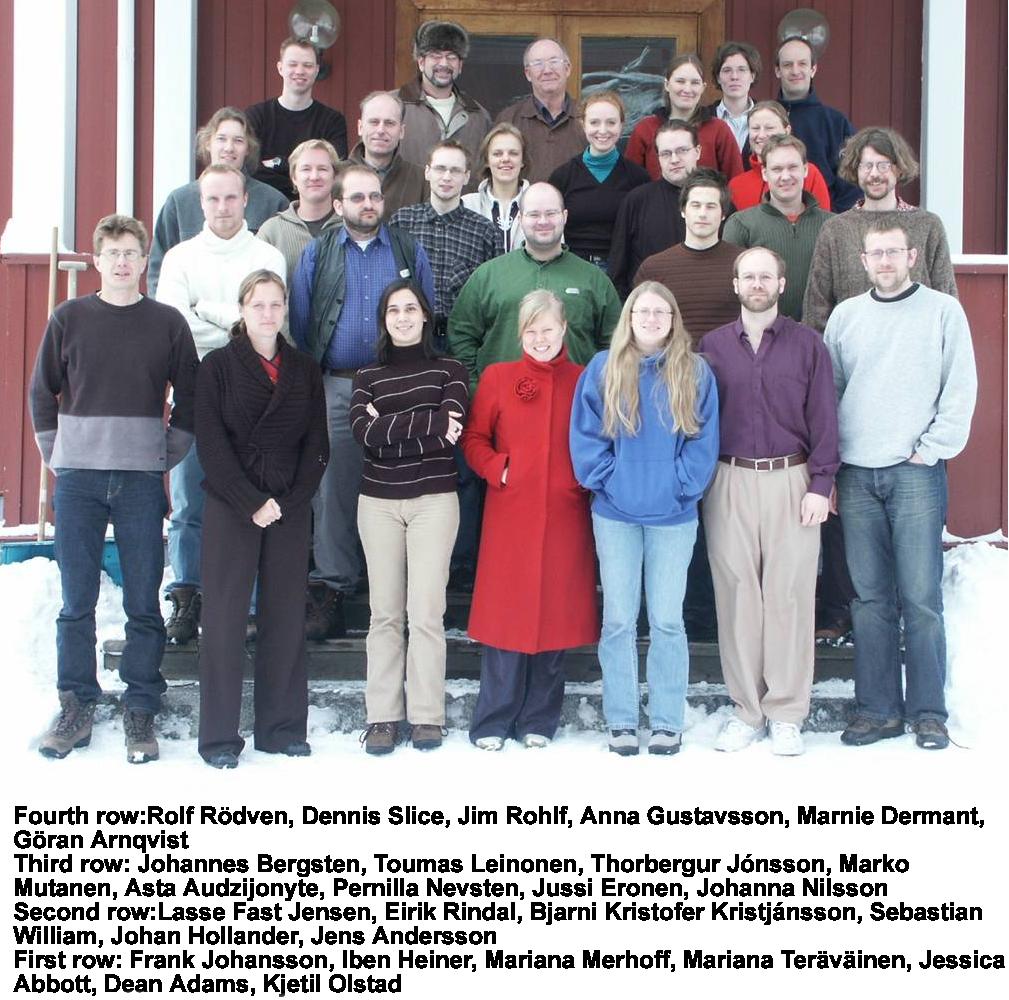
This workshop was held at Kronlund field station of Umeå University, Sweden during March 15-19 2004. The workshop was organized by Frank Johansson, Department of Ecology and Environmental Science, Umeå University and was supported by funding from NorFA, Nordic Academy for Advanced Study. Twenty students from the Nordic countries attended the workshop and the teachers were: F.J Rohlf (State University of New York, Stony Brook, USA), D. Adams (Iowa State University, USA), D. Slice (Wake Forest University School of Medicine, USA), and Göran Arnqvist (Uppsala University, Sweden). Jens Andersson and Johannes Bergsten, Umeå University, were co-organizers
With some modifications the schedule followed the outline used in some of the past workshops. During the first day Dean Adams talked about what shape is, how to measure it, what it describes and the problems that might be associated with how to measure shape James Rohlf gave an introduction to matrix algebra and multivariate statistics and Dennis Slice demonstrated software for data acquisition. The second day was devoted to superimposition methods (Dennis Slice) and Kendall shape space and tangent space (James Rohlf). Dennis Slice demonstrated software for superimposition. Day three included methods for outline data, Fourier analysis, superimposition using sliding points (James Rohlf), and exploratory and confirmatory methods for shape analysis (Dean Adams). Dennis Slice demonstrated software. The fourth day started with a presentation on comparative methods (James Rohlf) and continued with case studies (Dean Adams, Dennis Slice and Göran Arnqvist). During day 1-4 students worked with their own material during the afternoons and the evenings. The last day students presented work done during the week based on their own material.
This workshop aimed to give a thorough introduction for students with a little or no experience in geometric morhometrics. Due to a highly motivated group of students and professional teachers the course seems to have been very successful. At the end of the course, the students had included Fourier analysis as well as sliding landmarks as a common vocabulary in their scientific language, and hopefully geometric morphometrics will now be used more frequently also in the Nordic countries.
The following students participated and presented a "talk" on their
own work done during the workshop:
Jessica Abbott, University of Lund, Sweden
Asta Audzijonyte, University of Helsinki, Finland
Johannnes Bergsten, Umeå University, Sweden
Marnie Demandt, Uppsala University, Sweden
Jussi Eronen, University of Helsinki, Finland
Lasse Fast Jensen, University of Århus, Denmark
Anna Gustavsson, Uppsala University, Sweden
Iben Heiner, University of Copenhagen, Denmark
Johan Hollander, University of Gothenburg, Sweden
Thorbergur Jónsson, Icelandic Institute of Natural History, Iceland
Bjarni Kristofer Kristjánsson, Holar University College, Iceland
Tuomas Leinonen, University of Helsinki, Finland
Mariana Merhoff, University of Århus, Denmark
Marko Mutanen, University of Oulu, Finland
Pernilla Nevsten, University of Lund, Sweden
Johanna Nilsson, University of Lund, Sweden
Kjetil Olstad, University of Oslo, Norway
Eirik Rindal, University of Oslo, Norway
Rolf Rödven, University of Tromsö, Norway
Mariana Teräväinen, University of Helsinki, Finland
Sebastian Willman, Uppsala University, Sweden
Frank Johansson,
Department of Ecology and Environmental Science, Umeå University
